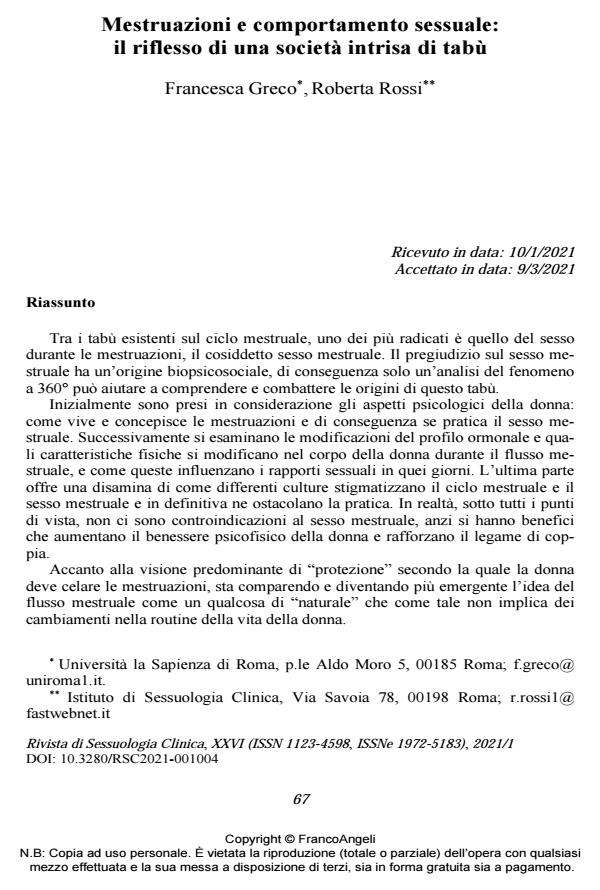Mestruazioni e comportamento sessuale: il riflesso di una società intrisa di tabù
Titolo Rivista RIVISTA DI SESSUOLOGIA CLINICA
Autori/Curatori Francesca Greco, Roberta Rossi
Anno di pubblicazione 2021 Fascicolo 2021/1
Lingua Italiano Numero pagine 13 P. 67-79 Dimensione file 166 KB
DOI 10.3280/RSC2021-001004
Il DOI è il codice a barre della proprietà intellettuale: per saperne di più
clicca qui
Qui sotto puoi vedere in anteprima la prima pagina di questo articolo.
Se questo articolo ti interessa, lo puoi acquistare (e scaricare in formato pdf) seguendo le facili indicazioni per acquistare il download credit. Acquista Download Credits per scaricare questo Articolo in formato PDF

FrancoAngeli è membro della Publishers International Linking Association, Inc (PILA)associazione indipendente e non profit per facilitare (attraverso i servizi tecnologici implementati da CrossRef.org) l’accesso degli studiosi ai contenuti digitali nelle pubblicazioni professionali e scientifiche
Tra i tabù esistenti sul ciclo mestruale, uno dei più radicati è quello del sesso du-rante le mestruazioni, il cosiddetto sesso mestruale. Il pregiudizio sul sesso me-struale ha un’origine biopsicosociale, di conseguenza solo un’analisi del fenomeno a 360° può aiutare a comprendere e combattere le origini di questo tabù. Inizialmente sono presi in considerazione gli aspetti psicologici della donna: come vive e concepisce le mestruazioni e di conseguenza se pratica il sesso me-struale. Successivamente si esaminano le modificazioni del profilo ormonale e quali caratteristiche fisiche si modificano nel corpo della donna durante il flusso mestruale, e come queste influenzano i rapporti sessuali in quei giorni. L’ultima parte offre una disamina di come differenti culture stigmatizzano il ciclo mestruale e il sesso mestruale e in definitiva ne ostacolano la pratica. In realtà, sotto tutti i punti di vista, non ci sono controindicazioni al sesso mestruale, anzi si hanno benefici che aumentano il benessere psicofisico della donna e rafforzano il legame di coppia. Accanto alla visione predominante di "protezione" secondo la quale la donna deve celare le mestruazioni, sta comparendo e diventando più emergente l’idea del flusso mestruale come un qualcosa di "naturale" che come tale non implica dei cambiamenti nella routine della vita della donna. Dunque, se il sangue mestruale può essere mostrato senza vergogna e in quei giorni possono essere compiute tutte le consuete attività, diventerà semplice con-cepire anche il sesso mestruale come semplice e spontaneo. In una più ampia prospettiva si comprende che eliminare questo tabù, non solo serve a restituire naturalità al fenomeno delle mestruazioni, ma costituisce un pas-so importante verso la parità di genere. In futuro, l’auspicio è che si sviluppi un di-battito più libero, che la ricerca scientifica e psicologica approfondisca questo am-bito e che si possano pertanto superare tabù e diseguaglianze legate al solo essere donna.
Parole chiave:mestruazioni, comportamento sessuale, sesso mestruale, tabù, protezione, naturale.
Francesca Greco, Roberta Rossi, Mestruazioni e comportamento sessuale: il riflesso di una società intrisa di tabù in "RIVISTA DI SESSUOLOGIA CLINICA" 1/2021, pp 67-79, DOI: 10.3280/RSC2021-001004